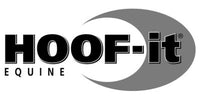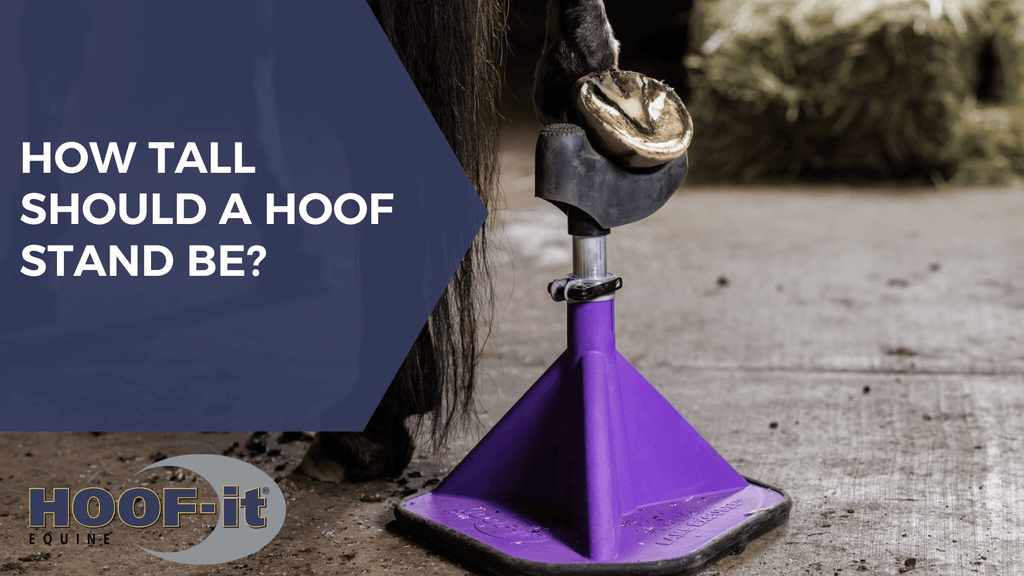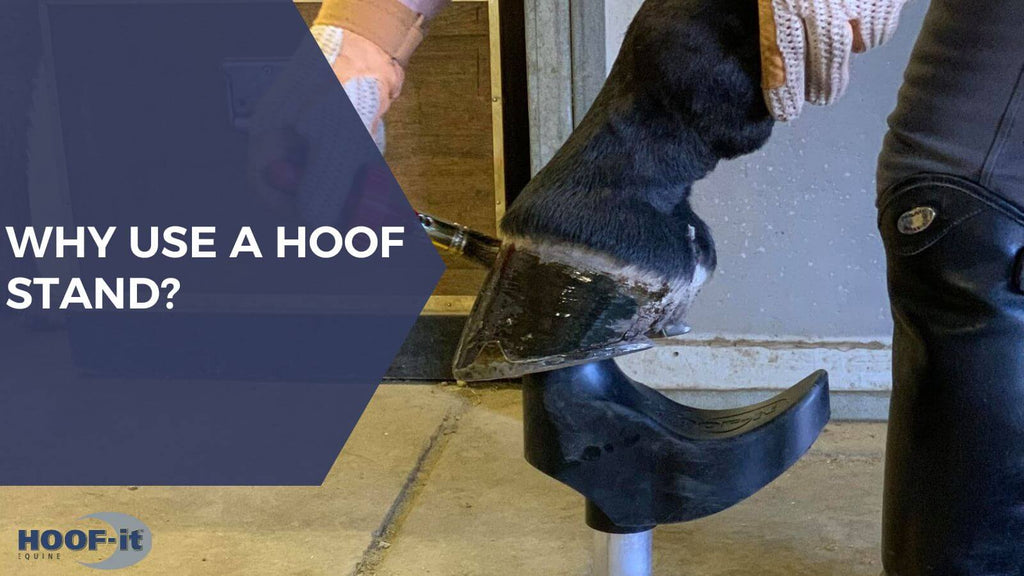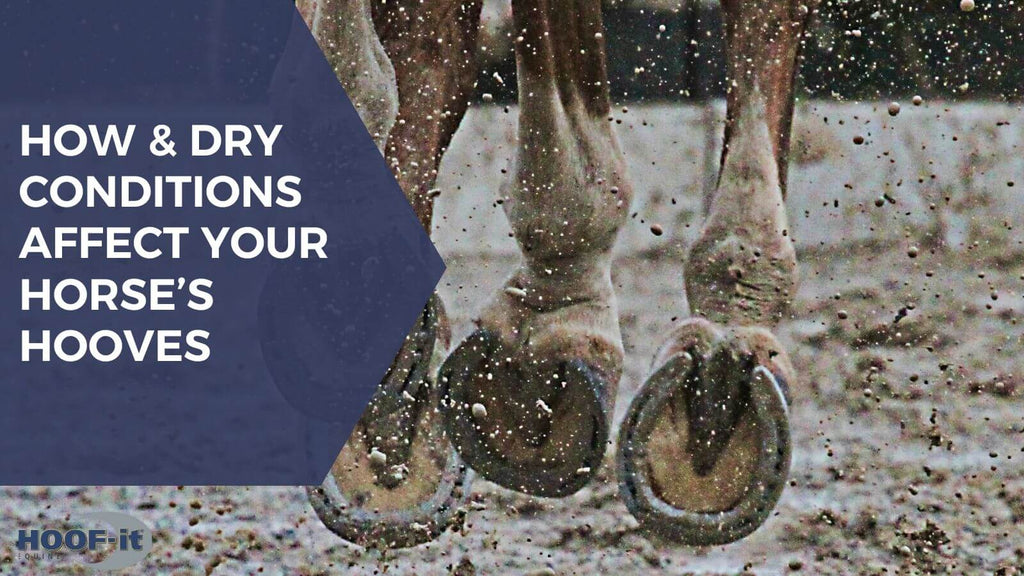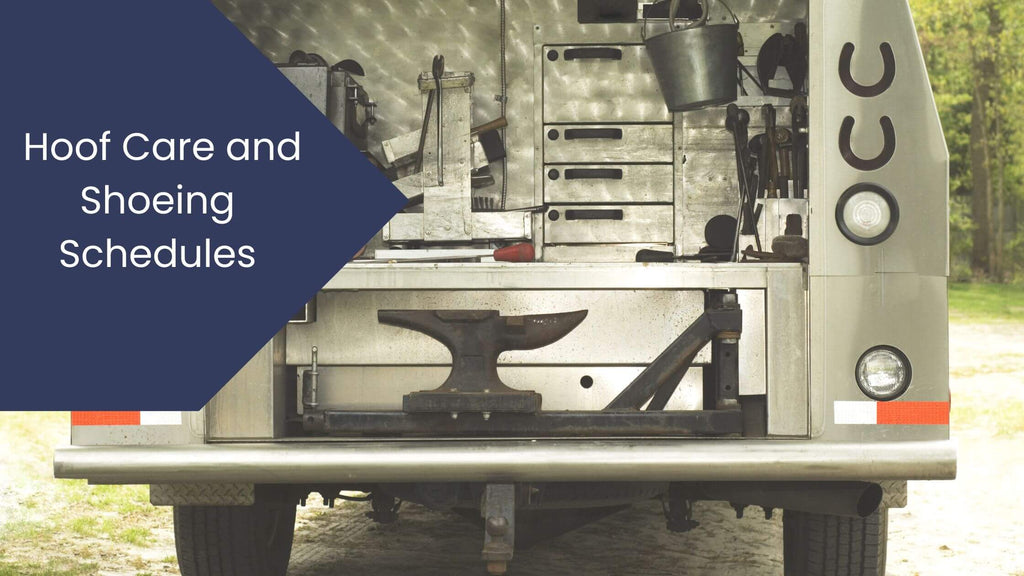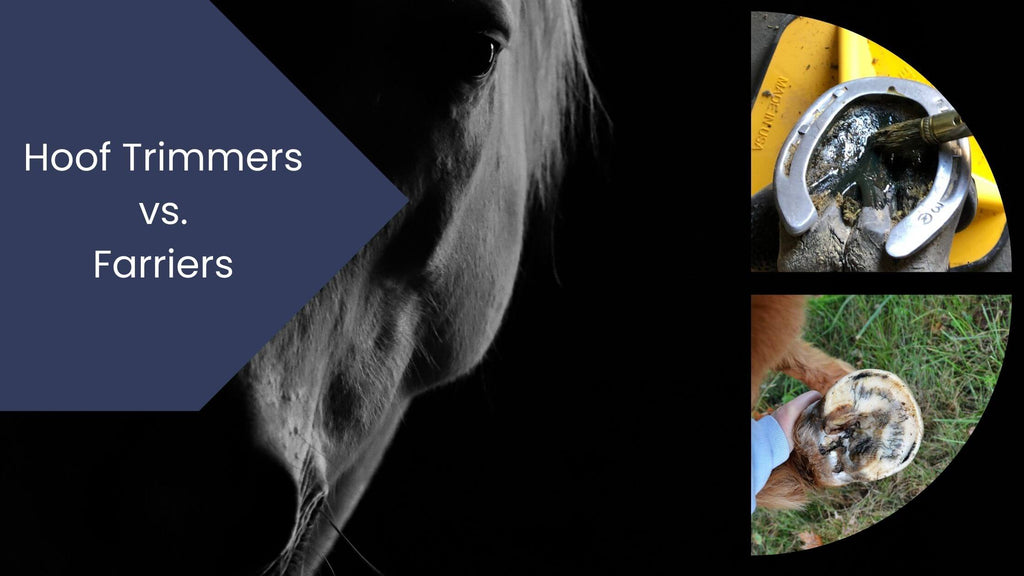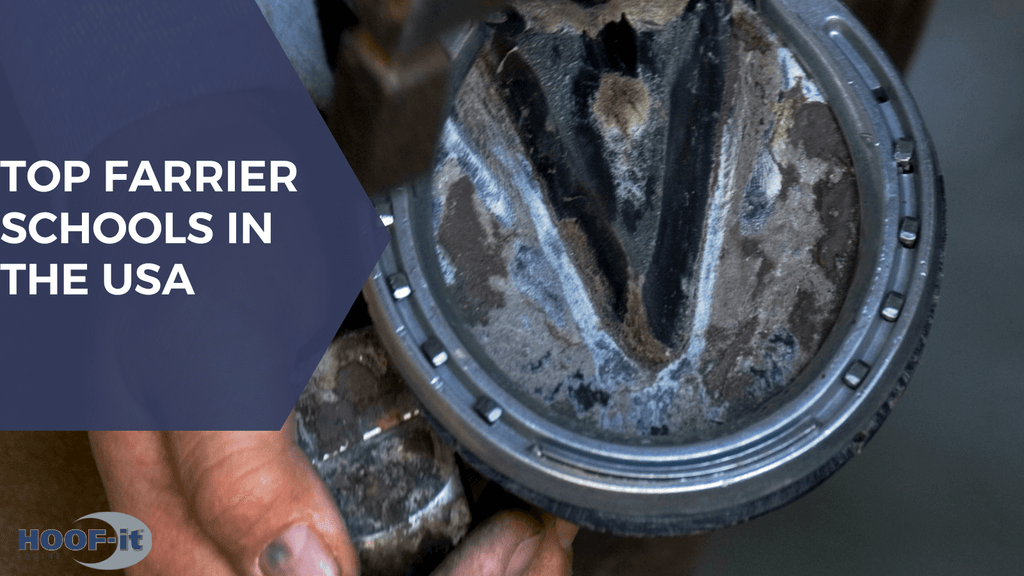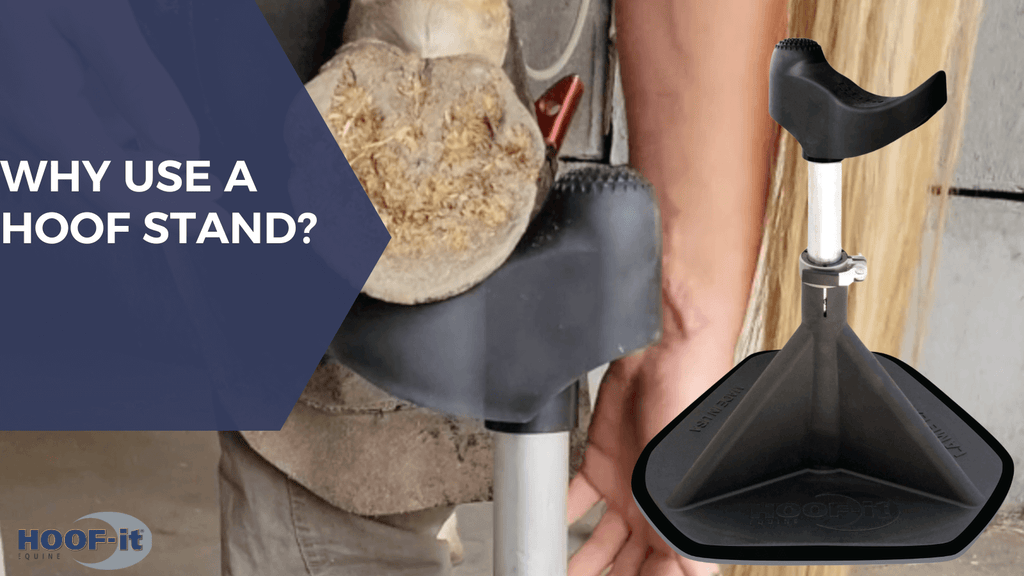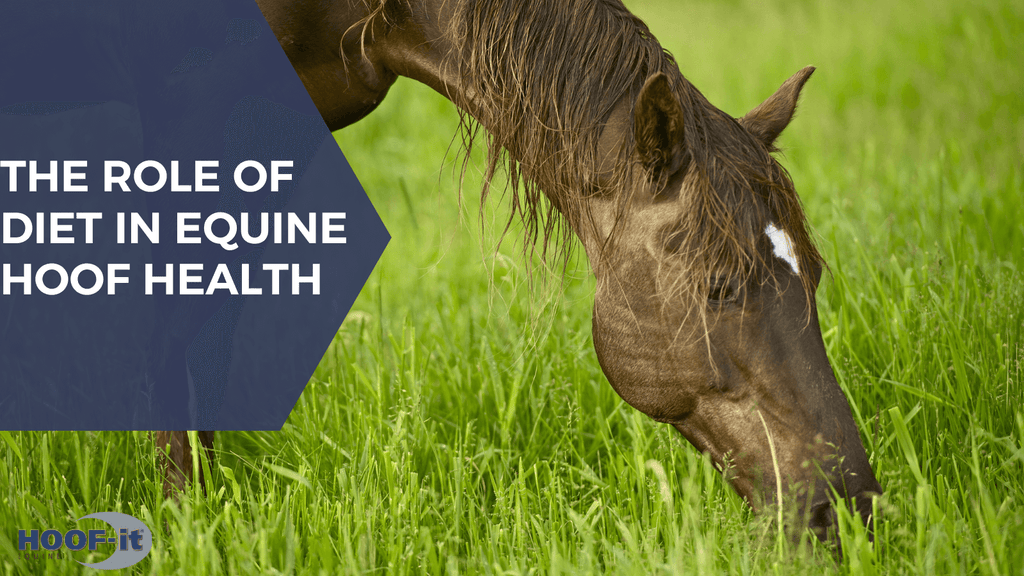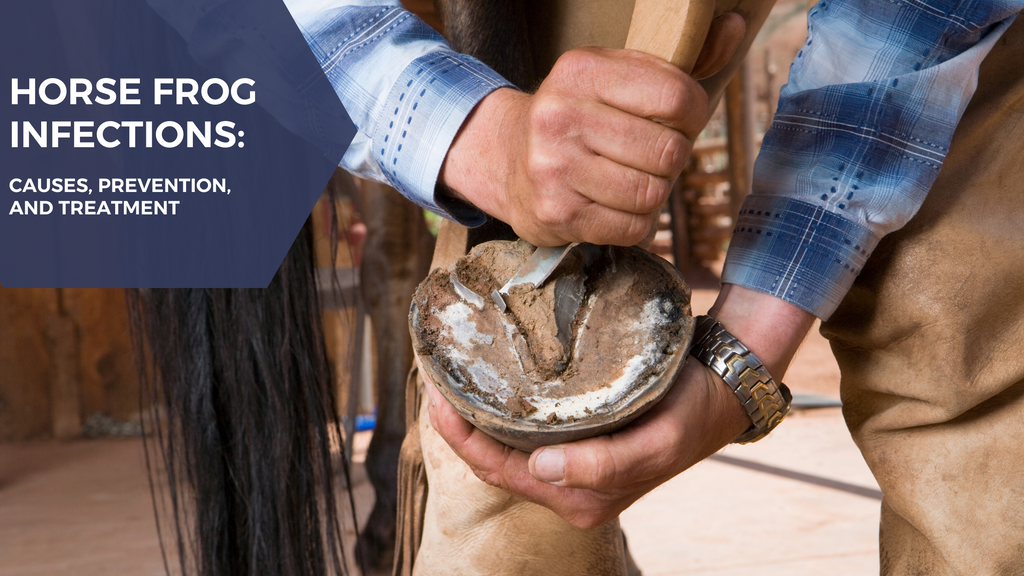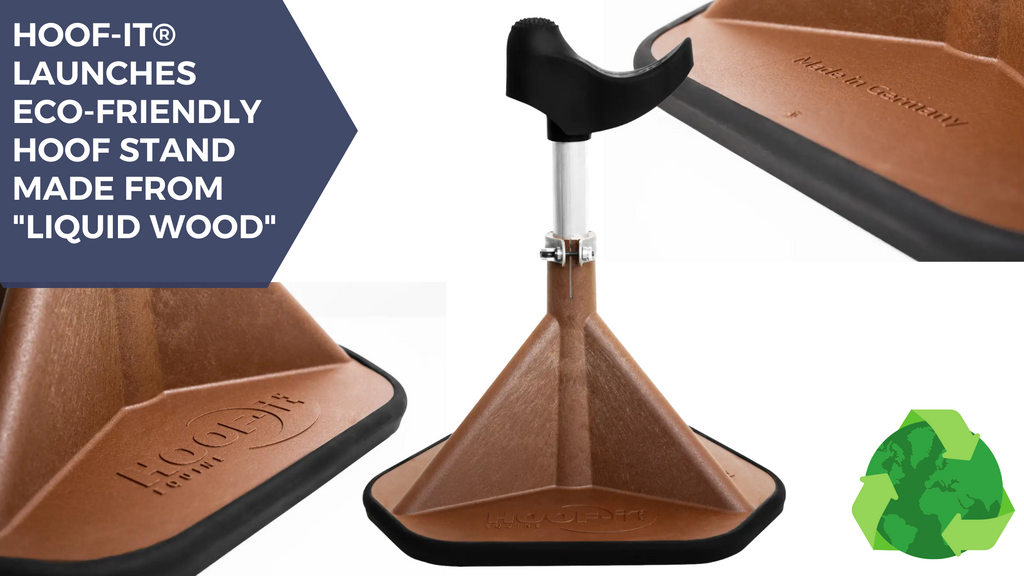HOOF-it Blog
The Importance of Utilizing a Hoof Stand in Equine Hoof Care
1. Ergonomic Benefits for Handlers
Frequent hoof maintenance can be physically taxing, often requiring handlers to sustain uncomfortable positions. A hoof stand alleviates the need to hold the horse's hoof manually, thereby reducing physical strain and the risk of back injuries. This ergonomic solution allows for longer, more frequent, and thus more effective hoof care sessions without the accompanying physical fatigue.
2. Enhanced Comfort for the Horse
A hoof stand supports the horse's hoof in a natural and stable position, minimizing discomfort and stress for the animal during care sessions. This is particularly advantageous for elderly horses and those with existing joint or muscle issues, facilitating a more compliant and less stressful experience.
3. Increased Safety
Utilizing a hoof stand minimizes the risk of accidental injuries to both the horse and handler by securing the hoof during maintenance. This stability is crucial when performing precise tasks such as trimming or applying treatments, significantly reducing the likelihood of mishaps.
4. Improved Quality of Hoof Care
A hoof stand provides a stable platform that allows for closer inspection and more accurate maintenance. By stabilizing the hoof, handlers can more easily identify and address issues such as cracks, infections, or foreign objects, thereby maintaining higher standards of hoof health.
5. Versatility and Adaptability
Modern hoof stands are designed with adjustable features to accommodate various breeds, sizes, and specific needs of horses. This adaptability ensures that the hoof stand can be used across a broad range of hoof care tasks with increased effectiveness and precision.
Conclusion
Incorporating a hoof stand into routine hoof care practices significantly enhances the quality of care provided while ensuring the safety and comfort of both the horse and handler. It is a critical investment for any equine facility committed to upholding the highest standards of animal welfare and operational efficiency.
The Delicate Balance: How Wet and Dry Conditions Affect Your Horse’s Hooves
Ah, the weather! It’s the one thing we horse owners love to complain about but have absolutely no control over. Yet, when it comes to our horses’ hooves, weather conditions can be more than just a minor inconvenience—they can be the difference between healthy, happy hooves and a painful trot down lameness lane. So, let’s dive into the world of wet and dry conditions and how they play tug-of-war with your horse’s feet.
The Impact of Wet Conditions
When Mother Nature decides to let loose with her rain and moisture, your horse’s hooves are on the front line. Extended exposure to wet conditions can lead to a few challenges:
-
Softened Hooves: Just like how your skin gets pruney after soaking in a bath too long, your horse’s hooves can become overly soft when exposed to wet conditions. This softening weakens the hoof wall, making it more susceptible to cracks, chips, and splits. Not to mention, a softer hoof is more prone to bruising, which can lead to soreness or even lameness.
-
Thrush and Bacterial Infections: Wet environments are breeding grounds for bacteria and fungi. When hooves stay damp, especially in muddy conditions, the likelihood of developing thrush or other bacterial infections skyrockets. Thrush is a particularly nasty infection that loves to settle in the frog area, causing pain and a foul odor. If left untreated, it can become severe enough to cause lameness.
-
Muddy Messes: Let’s not forget the sheer inconvenience of muddy pastures. When hooves are caked in mud, it’s not just messy—it can trap moisture against the hoof, exacerbating the softening and increasing the risk of bacterial infections. Plus, muddy conditions can cause horses to slip, leading to strains or injuries.
The Dry Spell: What Happens in Arid Conditions
On the flip side, when the rain stops and the sun beats down, we’ve got a whole new set of hoof challenges to contend with:
-
Brittle Hooves: Prolonged exposure to dry, arid conditions can have the opposite effect on hooves—they become too hard and brittle. A dry hoof is less flexible and more prone to cracks, chips, and even painful conditions like hoof abscesses. Brittle hooves also have a harder time absorbing shock, which can lead to soreness after work on hard ground.
-
Contracted Hooves: In extremely dry conditions, hooves can start to contract, leading to a tighter, less pliable structure. This contraction can cause discomfort, especially when a horse is asked to perform on hard surfaces. Over time, contracted hooves may also lead to changes in gait and posture, putting undue stress on joints and tendons.
-
Slow Growth: Dry conditions can also slow down hoof growth, which might sound like a blessing if you’re tired of frequent farrier visits. However, slow growth can be a problem if your horse has a hoof condition that requires regular trimming or if they’re recovering from an injury.
Finding the Balance: What Can You Do?
As horse owners, we can’t control the weather, but we can take steps to manage the effects of wet and dry conditions on our horse’s hooves:
-
Regular Farrier Visits: Keeping up with regular farrier appointments is crucial, regardless of the weather. A skilled farrier can help address the unique challenges that wet or dry conditions bring, whether it’s trimming away damaged hoof wall or advising on the best treatments for thrush.
-
Proper Hoof Care: In wet conditions, ensure hooves are cleaned and dried thoroughly after turnout. Consider using a topical hoof dressing that helps repel moisture. In dry conditions, moisturizing hoof products can help maintain flexibility and prevent brittleness.
-
Stable Management: When possible, provide your horse with a dry, clean place to stand, especially during prolonged wet weather. Conversely, in dry conditions, consider turning out during cooler parts of the day when the ground isn’t as hard.
-
Diet and Supplements: A balanced diet with the right nutrients is key to healthy hoof growth, no matter the weather. Consider adding a hoof supplement rich in biotin, zinc, and methionine to support hoof health from the inside out.
Wrapping Up
So, whether it’s a downpour or a drought, the weather plays a significant role in the health of your horse’s hooves. By staying proactive and adapting your care routine to the conditions at hand, you can keep those hooves strong, healthy, and ready to tackle whatever Mother Nature throws your way.
Remember, the key is balance—just like in riding, finding that sweet spot between wet and dry is essential for hoof health. Keep an eye on the forecast, listen to your farrier’s advice, and give your horse the hoof care they need to stay comfortable and sound all year round.
Keep Your Hoof Game Strong: Hoof Care and Shoeing Schedules
Today, we’re diving into a topic that's close to every equestrian's heart: hoof care and shoeing schedules. Whether you’re a seasoned rider or new to the horse world, understanding the ins and outs of proper hoof care is essential for your horse's health and performance. So, let’s get to it!
The Importance of Hoof Care
Your horse's hooves are the foundation of their overall well-being. Neglecting hoof care can lead to various problems, from minor discomfort to serious lameness. Here are some reasons why regular hoof care is crucial:
- Prevention of Infections: Regular cleaning and inspection help prevent thrush and other bacterial or fungal infections.
- Maintaining Balance: Proper trimming ensures your horse's hooves remain balanced, preventing uneven wear and potential joint issues.
- Enhanced Performance: Well-maintained hooves contribute to better performance, whether you're competing or trail riding.
Daily Hoof Care Routine
Daily attention to your horse's hooves can make a world of difference. Here's a simple routine to follow:
- Pick Out Hooves: Use a hoof pick to remove dirt, stones, and debris. Pay special attention to the frog and sole.
- Inspect for Issues: Look for signs of cracks, abscesses, or unusual smells that could indicate infections.
- Moisturize: Depending on your climate, you might need to apply a hoof conditioner to prevent dryness or cracking.
Shoeing Schedules
Shoeing schedules can vary depending on your horse's activity level, hoof growth rate, and the terrain they work on. However, a general guideline is to have your horse shod every 6 to 8 weeks. Here’s why sticking to a regular schedule is important:
- Consistent Wear and Tear: Regular shoeing helps manage the wear and tear on your horse’s hooves, preventing overgrowth and imbalance.
- Customized Care: A farrier can provide customized care based on your horse's specific needs, such as corrective shoeing for conformation issues.
- Seasonal Adjustments: Different seasons may require adjustments in shoeing to accommodate changes in terrain and activity levels.
Finding the Right Farrier
A good farrier is worth their weight in gold. Here are some tips for finding the right one:
- Ask for Recommendations: Talk to other horse owners, your vet, or trainers for recommendations.
- Check Credentials: Ensure your farrier has proper training and certification.
- Observe Their Work: Watch them work and ask questions to gauge their expertise and approach.
Special Considerations
Every horse is unique, and some may have special hoof care needs:
- Barefoot Horses: If your horse is barefoot, regular trims are even more critical to maintain hoof shape and health.
- Senior Horses: Older horses may need more frequent trims or specialized shoeing to address age-related issues.
- Performance Horses: Horses in intense training or competition might require specific shoeing strategies to enhance performance and protect their hooves.
Conclusion
Hoof care and a regular shoeing schedule are non-negotiable aspects of horse ownership. By staying proactive and partnering with a skilled farrier, you can ensure your horse’s hooves remain healthy and strong, setting the stage for a lifetime of happy, sound riding.
Remember, a little effort every day goes a long way in keeping those hooves in tip-top shape.
The Differences Between a Hoof Trimmer and a Farrier
The Differences Between a Hoof Trimmer and a Farrier
When it comes to horse care, understanding the nuances of hoof maintenance is essential for every equestrian. Two key professionals in this realm are the hoof trimmer and the farrier. While both play crucial roles in maintaining a horse's hoof health, their approaches and expertise differ significantly. Let's delve into the distinctions between a hoof trimmer and a farrier, and why each might be the right choice for your equine companion.
Hoof Trimmer: The Natural Approach
1. Focus on Barefoot Horses:
A hoof trimmer specializes in maintaining the hooves of barefoot horses. Their primary goal is to trim the hooves in a way that mimics the natural wear and tear a horse would experience in the wild.
2. Philosophy and Techniques:
The philosophy behind hoof trimming is rooted in the belief that a horse's hooves, when left unshod, are healthier and more resilient. Hoof trimmers use specific techniques to balance the hoof and encourage natural growth patterns. They often employ tools such as rasps and nippers to shape the hoof, ensuring it remains functional and free from disease.
3. Specialized Knowledge:
Hoof trimmers are usually well-versed in hoof anatomy and pathology, allowing them to address common hoof issues through natural methods. Their training often includes a deep understanding of how diet, environment, and exercise affect hoof health.
4. Holistic Care:
Many hoof trimmers advocate for a holistic approach to horse care, considering factors such as diet, exercise, and living conditions. They believe that a balanced lifestyle contributes significantly to the overall health of the hooves.
5. Use of Hoof Stands:
Both hoof trimmers and farriers utilize hoof stands to make their jobs easier on both the horse and the human. Hoof stands provide support for the horse's leg, allowing for a more stable and comfortable trimming process.
Farrier: The Traditional Craftsman
1. Shoe Application:
The most notable difference between a farrier and a hoof trimmer is that farriers are trained to apply horseshoes. This skill requires not only trimming the hoof but also shaping and fitting shoes to protect the hooves from wear and provide additional support, especially for horses that perform rigorous activities.
2. Comprehensive Training:
Farriers undergo extensive training that covers not only hoof trimming and shoeing but also forging and fabricating horseshoes. They must understand how to address various hoof and limb pathologies through corrective shoeing.
3. Therapeutic Expertise:
Farriers are often called upon to address more complex hoof issues that require therapeutic shoeing. This can include dealing with laminitis, navicular disease, and other structural problems that necessitate specialized shoeing techniques.
4. Custom Solutions:
A farrier’s ability to create custom shoes tailored to a horse’s specific needs is a significant advantage. This is especially crucial for performance horses, which might require specialized shoeing to enhance their athletic capabilities and protect them from injury.
Choosing Between a Hoof Trimmer and a Farrier
1. Horse's Needs:
The choice between a hoof trimmer and a farrier largely depends on your horse's specific needs. For horses that thrive barefoot and have healthy, natural hooves, a hoof trimmer's expertise in natural hoof care might be ideal. Conversely, if your horse requires shoes for protection, support, or therapeutic reasons, a farrier's skills are indispensable.
2. Discipline and Environment:
Consider your horse's discipline and environment. Performance horses, such as those in jumping, dressage, or racing, often benefit from the additional support that shoes provide. Horses in less demanding disciplines or those kept in natural environments may do well with a barefoot approach.
3. Hoof Health and Condition:
If your horse has existing hoof issues or is prone to certain conditions, a farrier might be better equipped to provide the necessary corrective measures. However, for ongoing maintenance of healthy hooves, a hoof trimmer's approach can promote natural strength and resilience.
Conclusion
Both a hoof trimmer and a farrier play vital roles in equine hoof care. Understanding the differences between their approaches can help you make informed decisions about your horse's hoof health. Whether you opt for the natural philosophy of a hoof trimmer or the traditional craftsmanship of a farrier, the key is to choose the professional whose skills align best with your horse's needs. By doing so, you'll ensure your equine companion's hooves remain healthy, strong, and ready for any adventure.
The Best Farrier Schools in the USA: Where Craftsmanship Meets Passion
In the equestrian world, the role of a farrier is indispensable. Farriers are skilled craftsmen and women who specialize in equine hoof care, encompassing the trimming and balancing of horses' hooves and the placing of shoes on their hooves, if necessary. This age-old profession blends art, science, and a deep love for animals, ensuring that horses maintain optimal hoof health and performance. For those drawn to this unique career path, choosing the right school is the first step toward mastering the craft. In this blog post, we'll trot through some of the best farrier schools in the USA, where passion for equine care is forged into expertise.
1. Oklahoma State Horseshoeing School - Ardmore, OK
Nestled in the heart of horse country, the Oklahoma State Horseshoeing School has been shaping top-tier farriers for decades. With a comprehensive curriculum that covers anatomy, pathology, and the principles of horseshoeing, students are prepared for a successful career in the field. The school offers various programs to suit different levels of experience, from beginners to those looking to refine their skills.
2. Kentucky Horseshoeing School - Richmond, KY
The Bluegrass State is synonymous with horse racing, making it a fitting location for one of the premier farrier schools in the country. The Kentucky Horseshoeing School prides itself on a rigorous program that not only teaches the technical skills needed for horseshoeing but also instills a deep understanding of equine anatomy and physiology. Graduates leave well-equipped to tackle the challenges of the farrier profession.
3. Pacific Coast Horseshoeing School - Plymouth, CA
Located in the scenic foothills of the Sierra Nevada, the Pacific Coast Horseshoeing School offers an immersive experience in farrier science. The school's philosophy centers on hands-on learning, with students spending ample time working directly with horses. This approach ensures that graduates are not only proficient in the technical aspects of the trade but also comfortable and confident in handling horses.
4. Cornell University Farrier Program - Ithaca, NY
For those looking for an academic setting, the Cornell University Farrier Program offers a unique blend of scholarly learning and practical experience. Affiliated with one of the leading veterinary schools in the country, the program provides an unparalleled understanding of equine health, alongside fundamental farrier skills. This combination prepares students for a career that may extend beyond traditional horseshoeing into equine health and research.
5. Heartland Horseshoeing School - Lamar, MO
Heartland Horseshoeing School is known for its intensive programs designed for serious students aiming for the pinnacle of farrier excellence. With a focus on forging and corrective shoeing, the curriculum is tailored to those aspiring to compete at national and international farriery competitions or to work with high-performance horses in various equestrian disciplines.
Choosing the Right Path
Selecting the right farrier school is a significant decision that can shape your career in the equine industry. Each of these schools offers something unique, whether it's a focus on hands-on experience, academic knowledge, or specialized skills. Prospective students should consider their career goals, learning style, and the type of equine industries they wish to serve when making their choice.
Becoming a farrier is not just about learning a trade; it's about embracing a lifestyle that celebrates the bond between humans and horses. It requires dedication, passion, and a continual desire to learn and improve. For those ready to embark on this journey, the schools listed above provide a gateway to a rewarding career, blending craftsmanship with the love of equine companions.
Remember, in the world of farriery, your education is the foundation upon which you will build your career. Choose wisely, and let your passion for horses guide you to the right school. Happy shoeing!
Why You Should Be Using a Hoof Stand in Your Hoof Care Business
In the world of equine care, precision, safety, and efficiency are not just goals—they are necessities. For professionals dedicated to maintaining the health and performance of horses, every tool in their arsenal plays a crucial role in achieving these objectives. Among these essential tools, the hoof stand stands out (pun intended!) as a game-changer for farriers and hoof care specialists. And when it comes to selecting the best hoof stand on the market, the Hoof-it Blacksmith model is unparalleled. Here’s why incorporating a hoof stand into your hoof care business is a smart move and why the Hoof-it Blacksmith should be your top choice.
The Importance of a Hoof Stand in Hoof Care
Ergonomic Efficiency
A hoof stand supports the horse's hoof during trimming, shaping, and shoeing processes, reducing strain on both the horse and the farrier. This ergonomic efficiency not only makes the job easier but also significantly decreases the risk of injury and fatigue. With a hoof stand, professionals can maintain a better posture, focusing on precision without the distraction of discomfort.
Safety First
Safety is paramount in any equine-related activity. A hoof stand stabilizes the hoof, minimizing the risk of slips and accidental injuries. This stability is crucial when working with tools like nippers, rasps, and knives. A secure hoof means a safer environment for both the equine and the human.
Enhanced Precision
Precision in hoof care cannot be overstated. The right hoof stand allows for adjustments in height and angle, providing the perfect position for detailed work. This level of control ensures that each cut, trim, or file is as accurate as possible, leading to better hoof health and performance.
Why Hoof-it Blacksmith Stands Above the Rest
Unmatched Quality
The Hoof-it Blacksmith hoof stand embodies the pinnacle of quality. Designed with both the professional farrier and the horse in mind, it features durable construction that can withstand the rigors of daily use. Its robust design ensures longevity, making it a wise investment for any hoof care business.
Versatility and Innovation
What sets the Hoof-it Blacksmith apart is its innovative design, catering to a wide range of hoof sizes and shapes. Its versatility makes it suitable for various breeds and disciplines, from racing thoroughbreds to working draft horses. The ability to adjust height and hoof rest angle allows for a custom fit for each horse, enhancing the precision and effectiveness of your work.
Ergonomic Design for Ultimate Comfort
The Hoof-it Blacksmith stand is engineered for ergonomics, offering features that significantly reduce strain on the farrier. Its thoughtful design ensures that you can work longer and more comfortably, translating to a higher quality of service for your clients and their horses.
A Trustworthy Investment
Choosing the Hoof-it Blacksmith hoof stand is not just about buying a tool; it's about investing in your business's future. Its durability, combined with the efficiency and safety it brings to your work, makes it an indispensable asset. This stand not only elevates the standard of care you provide but also underscores your commitment to professional excellence.
Conclusion
Incorporating a hoof stand into your hoof care routine is a decision that brings immediate benefits in terms of safety, efficiency, and precision. And when it comes to choosing the best, the Hoof-it Blacksmith stands out as the premier choice for professionals who refuse to compromise on quality and innovation. Elevate your hoof care business to new heights with a tool that blends functionality with excellence. The Hoof-it Blacksmith hoof stand is not just a tool; it's your partner in ensuring the health and performance of the horses in your care.
The Role of Diet in Equine Hoof Health
Nutrition Tips for Stronger Hooves
As a horse owner, you understand the significance of proper nutrition for your equine partner, overall health and well-being. However, did you know that a well-balanced diet contributes to strong and healthy hooves? In this blog, we will discuss nutrients and dietary tips that contribute to stronger hooves.
Quality Forage as the Foundation
High-quality forage, such as grass and hay, should form the foundation of your horse's diet. Forage provides essential nutrients like fiber, vitamins, and minerals that are crucial for hoof health.
Protein for Hoof Growth and Repair
Protein is a vital component of hoof growth and repair. Ensure your horse's diet includes a sufficient amount of high-quality protein sources like alfalfa, soybean meal, or linseed meal. Protein aids in developing strong, resilient hooves that can withstand the rigors of daily activities.
Biotin - The Hoof Vitamin
Biotin, also known as vitamin B7, is often hailed as the "hoof vitamin" due to its significant impact on hoof quality. Among its most important functions is the production of keratin, the protein that makes up the hoof wall. Consider adding biotin supplements to your horse's diet, but consult your veterinarian for the appropriate dosage.
Essential Minerals
Certain minerals are essential for maintaining healthy hooves. Zinc, copper, and manganese are particularly important for hoof strength and integrity. These minerals support collagen production, which contributes to the overall structure of the hoof. Ensure your horse's diet includes balanced mineral supplements or feeds formulated to meet these specific needs.
Omega-3 Fatty Acids for Hoof Health
Omega-3 fatty acids have numerous benefits for horses, including improved hoof health. These essential fats have anti-inflammatory properties, which can aid in reducing inflammation associated with hoof problems. Omega-3 fatty acids can be found in flaxseed, chia seeds, and fish oil supplements.
Manage Carbohydrate Intake
Controlling carbohydrate intake is essential for horses prone to metabolic issues like laminitis. Diets high in sugars and starches can lead to insulin spikes and subsequent hoof problems. Choose low-starch feeds and limit access to lush, high-sugar pastures, especially for horses with metabolic conditions.
Hydration Matters
Adequate hydration is vital for overall health, including hoof health. Make certain your horse has access to fresh clean water at all times. Hydration supports proper blood flow to the hooves, aiding in the delivery of essential nutrients.
Regular Dental Care
Maintaining proper dental health is essential. Effective chewing and digestion of food are vital for nutrient absorption and overall health.
The old saying "no hoof, no horse" holds true, emphasizing the significance of hoof health in your horse's life. A well-balanced diet that includes high-quality forage, adequate protein, biotin, essential minerals, omega-3 fatty acids, and controlled carbohydrates is essential for maintaining strong and healthy hooves. Regular hoof care combined with a nutritious diet ensures your horse enjoys a solid foundation, allowing them to thrive in their daily activities and providing you with a happy, healthy equine companion. Remember to consult with your veterinarian or equine nutritionist to tailor a diet that best suits your horse's individual needs.
